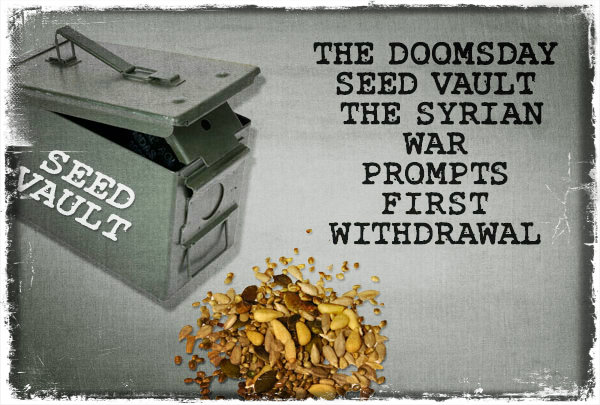
There is a “doomsday” vault built in an Arctic mountainside to safeguard global food supplies. Now for the first time since the vault was established on the Svalbard archipelago in 2008, seeds have been withdrawn. The original intent or charter if you will was designed to protect crop seeds such as beans, rice, and wheat against the worst cataclysms of nuclear war or disease (Doyle, 2015).
Once you crack the seal, or pop the cork as the case maybe, it is easier to go back to the wine for a sip or two, and sooner than imagined the bottle is empty. The vault has more than 860,000 samples, from almost all nations and of course the seeds are stored so the world or a particular nation can recover from a catastrophe, a catastrophe that threatens the food supply.
The Middle East as a whole could probably qualify as a catastrophe, where disease and starvation account for many deaths, not to mention war. With the refugee crisis and millions leaving the area is there anyone left to plant the crops and harvest them, process them, and then distribute them?
It won’t take long for the terrorist organizations who are trying to take over certain countries to realize they too need to eat and have a reliable food source, so what happens when, because of their actions the seed vault is tapped again, and again, and how long can it sustain itself. Maybe it’s time you started your own seed vault.
The doomsday seed vault is for countries to secure their future food supply, and while you live in a country, you would not be able to call up and order up your tomato seeds from the vault, if disaster strikes. It would take years after a calamity for nations to get the seeds in the ground. It requires people with skills to plant, tend to, and then to harvest the crops, not to mention once you have all this how to distribute the crops. Once again, you realize you are on your own.
We are not going to get into the debate about GMO’s, heirloom, hybrid, and all that. That is for you to decide what is best for you and yours. However, when the SHTF your choices may be limited, so if you want perfection and will not settle for less than perfect, then it is up to you to make it happen now, because no one will do it for you once a crisis is upon us.
Droughts, floods, a volcano, war, or even a major earthquake could ruin crops and crop land for years, and it would take years to recover. This means you would need several years’ worth of food stockpiled, or a sustainable and renewable source of food, your own private source in other words.
What Do You Need
Gathering up seeds is the easy part, and relatively inexpensive. If you only plant heirloom seeds then the plant itself will produce seeds ensuring a renewable source of seeds for every season. However, many heirloom varieties have inherent weaknesses. They are not drought tolerant, pest resistant and in some cases the growing conditions need to be near perfect for a decent harvest. Hybrid plants cannot produce seeds for an identical plant. However, the plant itself has had the best qualities bred into it and so hybrids are more suited for problem soil, and in many cases require less water. This is something to consider as you begin your stockpile, think about a combination of both.
Aside from the seeds, you will need certain skill sets, materials, and above all knowledge of the growing seasons, and of the plants themselves. Knowing how to compost properly will ensure you have fertilizer and the tools needed are not complicated, or all that expensive, but needed nonetheless.
The biggest problem is space and soil. If you live in a suburban area, vacant lots and other areas of the city could be contaminated after years of vehicular traffic and factories discharging contaminates into the soil. One solution is to stockpile your own soil, which would be a monumental task and you could use raised beds virtually anywhere. If you have a backyard suitable in size then that problem is solved, but consider the need to expand when calculating size of area versus harvest.
It takes planning and it can take months if not years to reach the level where your garden could supply you with daily sustenance during the growing season. Keep in mind you need to grow enough so there is a surplus that can be preserved for the off seasons.
Doyle, A. (2015, September 22). Retrieved 2015, from https://news.yahoo.com/syrian-war-spurs-first-withdrawal-doomsday-arctic-seed-143300148.html